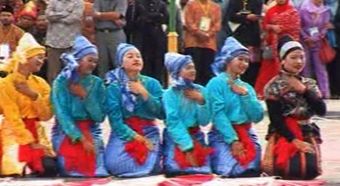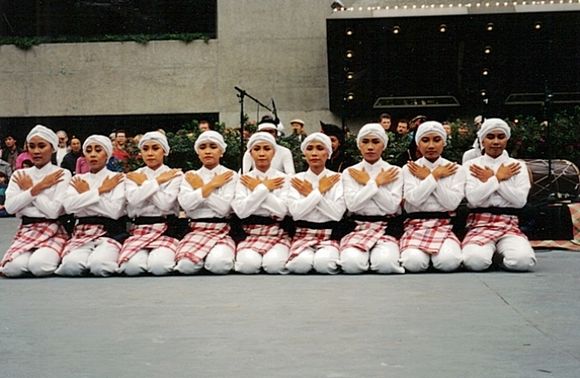Margaret Kartomi
An Acehnese ratoh duek (dance in sitting position)Iwan Imar |
In 2004, the people of Aceh were in the unfortunate yet unique position of having to endure both the armed civil conflict, which had begun in 1976, and the massive natural disaster of the tsunami on 26 December, in which around 200,000 people died, including thousands of artists. Along with the many musicians and dancers who lost their lives, rehearsal spaces and musical instruments were also destroyed. Humanitarian aid was despatched from sources within Indonesia and 133 foreign countries offered substantial aid. However, relief efforts were severely hampered by the continuing civil conflict. With the world’s media focusing on Aceh for the first time – and with international pressure being applied to end the fighting – the Indonesian government and the Free Aceh Movement (GAM) struck a peace accord. However, the misery caused by the conflict, compounded by the tsunami, remained a source of significant trauma for many survivors.
The Arts during the conflict
During the conflict, especially from 1989 to 2005, regular artistic and ceremonial activity in most rural and urban villages ceased because of fragile security and frequent curfews. Even when a curfew was lifted, people tended to stay at home in the evenings in fear of their lives. Traditionally, artistic performances at life-event ceremonies lasted a week or more, but these were abandoned. Young people in particular had few opportunities to learn and perform traditional and popular music and dances, and the standards of artistry declined through lack of teaching time and performance opportunities. In most areas, the old Acehnese habit of holding frequent artistic competitions between villages ceased. Moreover, during the conflict most performing groups were starved of funds, and were unable to function.
Like the Dutch colonial rulers and the Indonesian anti-Darul Islam forces before them, from the early 1990s until 2005 government authorities also prohibited singers of religious and fictional stories from performing the several versions of the Hikayat Prang Sabi (Holy War Epic) for fear they would arouse further discontent and facilitate calls to arms among their audiences. However, it was common knowledge that printed and handwritten copies of the books were readily available. The authorities also tried to ban other seditious performances, but as the Indonesian government officials could not understand the Acehnese language in which the bards were singing, they were unable to do so effectively.
Even when a curfew was lifted, people tended to stay at home in the evenings in fear of their lives
While Jakarta and Aceh’s provincial government allowed, indeed promoted, the singing of regional Acehnese and national songs in schools and at election campaigns, it is no surprise that it banned the traditional and newly composed songs sung by members or supporters of the GAM resistance. The military screened songs regarded as having potentially critical content. This screening extended even to well-known lullabies and west-Acehnese laments that were traditionally used for singing about Acehnese heroes and heroines during the colonial war against the Dutch (1883–1910), and even during the Darul Islam conflict. Some commercially produced popular songs on politically topical subjects were also confiscated, including the song Nanggroe Merdeka (Independent Homeland) performed by the local singer Yusbi Yunus. Especially from 2000, such songs became an increasingly popular method of protest at the unhappy politico-military situation.
Before the peace agreement was signed in 2005, only troupes that were officially supported by the government elite and commercial recording companies were able to continue to rehearse, perform, and develop new items or reinterpretations of traditional pieces. There were some exceptions, however. The official performing troupes supported by the provincial governor and the district heads received protection and some funding for the maintenance of their chosen traditional forms, including the ‘sitting dances’ (ratôh duek), and standing dances such as seudati and phô.
 |
A Mass Dance with traditional body percussion at the Festival
|
The creation of new troupes was also supported. Throughout the New Order (1965–1998) they were frequently asked to perform at government functions, election campaigns and celebrations that marked the national and religious days, and at the major arts festivals. The government organised All-Aceh Arts Festivals in 1972, 1985, 1993 and 2004, and the Festival of Acehnese Dance and Shawm in Lhokseumawe in 2003. Scores of local young men and women were required to take part in the newly created tari masal (mass dances) at the official opening and closing ceremonies. Nevertheless, these events were too infrequent to maintain a healthy community arts scene throughout the province.
The Indonesian army itself played a small role in preserving Acehnese tradition. Its soldiers sometimes performed the traditional song-dance genre called ratôh duek (lit. ‘sitting chattering’) as a military exercise. This vigorous and strenuous dance is performed by a row of men who sit close together in half-kneeling position or rise up on their knees as they sing, dance, and perform unison or interlocking body percussion, clapping and beating their thighs, shoulders and the floor in cyclic rhythmic textures. Apart from the official and military groups, however, the lives of ordinary artists in the towns and villages were severely impeded by the wartime bans and curfews.
The tsunami
Immediately following the tsunami, television and radio stations, both nation-wide and provincial, began to broadcast tsunami-related news virtually non-stop for months afterwards. For example, west-coast Acehnese singers Marzuki Hassan, of the Jakarta Arts Institute, and the popular singer Rafly, of Studio Kande, sang the tragic, high-pitched west-coast laments on the national media, especially Metro TV. Their involvement in Aceh’s recovery was to extend far beyond their immediate audiences and the pockets of potential donors. They and many other artists took part in efforts to alleviate the trauma of the tsunami survivors through music.
Many coastal villages had lost virtually all their artists to the tsunami, and were hard pressed to find anyone to perform the usual traditional music and dances at their weddings and other celebrations
Of the thousands of artists who died in the tsunami, an estimated 25–35 per cent were aged 10 to15 years, and more than half were women. Several NGOs employed performing and visual artists to teach traditional music, dance and visual arts to groups of children, especially orphans, and women to alleviate their trauma. An international exhibition of artworks created by children was set up in a building complex not far from Banda Aceh’s airport, attracting many visitors. Orphan choirs performed heart-rending songs about the tsunami at various functions.
To aid recovery from trauma, the government’s Rehabilitation and Reconstruction Agency for Aceh and Nias (BRR) and some NGOs also commissioned the manufacture of musical instruments, especially frame drums, to replace those lost to the waves, and the sewing and embroidering of new dance costumes. Some rehearsal and class spaces were rebuilt but many were not, and this severely limited a return to normal music-making and the re-establishment of classes for young artists.
Many coastal villages had lost virtually all their artists to the tsunami, and were hard pressed to find anyone to perform the usual traditional music and dances at their weddings and other celebrations. They feared that their traditional customs and arts – their very identity – had been lost forever. A few troupes whose equipment was destroyed by the tsunami nevertheless survived through the resilience and ingenuity of their leaders. In one village, for example, only one ratôh duek performer survived from the complete group. An NGO encouraged him to assume the artistic responsibilities of the former troupe leader and to seek out and teach young artists in the village so that the troupe would again have sufficient players for such performances.
The peace accord
None of these examples of resilience and recuperation after the tsunami would have been possible, of course, had the armed conflict continued. After Jakarta and GAM had signed the peace accord, the BRR and the NGOs employed select groups of artists to help prevent a return to the long-running conflict and to spread the message of peace. They included Aceh’s best-known music group, Kande Saweu Syedara, led by Rafly. He creates peace songs that feature traditional Acehnese music-making techniques, including interlocking body percussion, as well as many musical influences from the international pop media.
After the peace accord had been signed there was a gradual proliferation of artistic activity at the grassroots level in the urban and rural villages
In early 2008 the National Development Planning Agency (BAPPENAS) in Jakarta allocated funding for its Program for the Socialisation, Peace and Re-integration of Aceh, ‘to strengthen sustainable peace and reintegration in Aceh, and to restore energy for the growth and development of Acehnese culture, which virtually died out in the decades of conflict’. As the 2005 Peace Accord had stressed the need for the government to re-integrate former independence fighters into society and to provide them with employment, it instituted a ‘campaign for peace and re-integration of disaffected elements’. However, work was found only for a proportion of former GAM combatants, with some failing to be ‘re-integrated into Acehnese society’.
Other funding was allocated to the Cooperative Forum for Peace in Aceh as part of a campaign to maintain the peace, in part by commissioning artists to create peace songs and poems in the lead-up to the Accord’s third anniversary in 2008. A rally on 15 August 2008, a precursor to the 63rd celebration of Indonesia’s Independence on 17 August, used a variety of media resources in the celebrations. It included a press conference about projects instituted since the peace agreement, a peace-song composing competition, forums led by religious leaders, public prayers, and Friday sermons. Supported by aid funds from several NGOs, the Forum planned more than thirty events involving performing art troupes. New songs on the peace theme were commercially produced and issued in an Album of Acehnese Peace Songs on DVD, VCD, MP3, Ring Tone and Cassette.
The most significant artistic development after the peace accord had been signed, however, was the gradual proliferation of artistic activity at the grassroots level in the urban and rural villages, and the consequent raising of performance standards. Unlike the activities of the government and NGOs, this was a spontaneous response by people everywhere to the removal of the curfews. Despite widespread fears that the peace would not last, many communities throughout Aceh slowly began to return to normalcy. In the performing arts, this meant people returned to a modified version of their traditional practices, including lengthy family celebrations with artistic performances. In the first week of July 2007, I attended a three-day wedding with music and dance performances each evening in Blangpidie, Kabupaten Aceh Barat Daya, and also a three-day circumcision ceremony and celebration with music and dance in Desa Blang Seumoet, Kecamatan Betung, Kabupaten Nagan Raya.
Performance standards improved perceptibly as regular rehearsals were held once more and artists could focus on perfecting their craft. Performing arts teachers opened or re-opened their music and dance schools and troupes (sanggar) or taught the religious arts in the Islamic schools (madrasah) again. Professional and semi-professional performing groups and pop bands sprang up in many towns and villages, assisted by producers and other stakeholders. Commercial companies sponsored a thriving cassette and VCD recording industry, publicising the most popular music and dance bands in the towns. In 2008, some performing arts groups were optimistically planning artistic activities for 2009 and beyond. However, knowing that the massive input of aid was to cease in March 2009, they were apprehensive about the future of the arts in the potentially unstable economic and political situation that might ensue. ii
Margaret Kartomi is Professor in the School of Music-Conservatorium at Monash University. Gratitude is expressed to the many artists and government officials in Aceh who gave assistance during field trips in 1982, 2003, 2004, 2007 and 2008. Gratitude is expressed also to Hidris Kartomi and to Iwan Amir for support on field trips and for permission to reproduce photographs.
